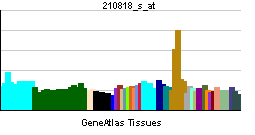BACH1
| BTB and CNC homology 1, basic leucine zipper transcription factor 1 | |||||||||||||
|---|---|---|---|---|---|---|---|---|---|---|---|---|---|
 PDB rendering based on 2ihc. | |||||||||||||
| |||||||||||||
| Identifiers | |||||||||||||
| Symbols | BACH1 ; | ||||||||||||
| External IDs | Template:OMIM5 Template:MGI HomoloGene: 916 | ||||||||||||
| |||||||||||||
| RNA expression pattern | |||||||||||||
 | |||||||||||||
 | |||||||||||||
| More reference expression data | |||||||||||||
| Orthologs | |||||||||||||
| Template:GNF Ortholog box | |||||||||||||
| Species | Human | Mouse | |||||||||||
| Entrez | n/a | n/a | |||||||||||
| Ensembl | n/a | n/a | |||||||||||
| UniProt | n/a | n/a | |||||||||||
| RefSeq (mRNA) | n/a | n/a | |||||||||||
| RefSeq (protein) | n/a | n/a | |||||||||||
| Location (UCSC) | n/a | n/a | |||||||||||
| PubMed search | n/a | n/a | |||||||||||
BTB and CNC homology 1, basic leucine zipper transcription factor 1, also known as BACH1, is a human gene.[1]
This gene encodes a transcription factor that belongs to the cap'n'collar type of basic region leucine zipper factor family (CNC-bZip). The encoded protein contains broad complex, tramtrack, bric-a-brac/poxvirus and zinc finger (BTB/POZ) domains, which is atypical of CNC-bZip family members. These BTB/POZ domains facilitate protein-protein interactions and formation of homo- and/or hetero-oligomers. When this encoded protein forms a heterodimer with MafK, it functions as a repressor of Maf recognition element (MARE) and transcription is repressed. Multiple alternatively spliced transcript variants have been identified for this gene. Some exons of this gene overlap with some exons from the C21orf41 gene, which is transcribed in an opposite orientation to this gene but does not seem to encode a protein.[1]
References
Further reading
- Ozono R (2006). "New biotechnological methods to reduce oxidative stress in the cardiovascular system: focusing on the Bach1/heme oxygenase-1 pathway". Current pharmaceutical biotechnology. 7 (2): 87–93. PMID 16724942.
- Oyake T, Itoh K, Motohashi H; et al. (1996). "Bach proteins belong to a novel family of BTB-basic leucine zipper transcription factors that interact with MafK and regulate transcription through the NF-E2 site". Mol. Cell. Biol. 16 (11): 6083–95. PMID 8887638.
- Bonaldo MF, Lennon G, Soares MB (1997). "Normalization and subtraction: two approaches to facilitate gene discovery". Genome Res. 6 (9): 791–806. PMID 8889548.
- Ohira M, Seki N, Nagase T; et al. (1998). "Characterization of a human homolog (BACH1) of the mouse Bach1 gene encoding a BTB-basic leucine zipper transcription factor and its mapping to chromosome 21q22.1". Genomics. 47 (2): 300–6. PMID 9479503.
- Blouin JL, Duriaux Saïl G, Guipponi M; et al. (1998). "Isolation of the human BACH1 transcription regulator gene, which maps to chromosome 21q22.1". Hum. Genet. 102 (3): 282–8. PMID 9544839.
- Kobayashi A, Yamagiwa H, Hoshino H; et al. (2000). "A combinatorial code for gene expression generated by transcription factor Bach2 and MAZR (MAZ-related factor) through the BTB/POZ domain". Mol. Cell. Biol. 20 (5): 1733–46. PMID 10669750.
- Hattori M, Fujiyama A, Taylor TD; et al. (2000). "The DNA sequence of human chromosome 21". Nature. 405 (6784): 311–9. doi:10.1038/35012518. PMID 10830953.
- Kanezaki R, Toki T, Yokoyama M; et al. (2001). "Transcription factor BACH1 is recruited to the nucleus by its novel alternative spliced isoform". J. Biol. Chem. 276 (10): 7278–84. doi:10.1074/jbc.M004227200. PMID 11069897.
- Cantor SB, Bell DW, Ganesan S; et al. (2001). "BACH1, a novel helicase-like protein, interacts directly with BRCA1 and contributes to its DNA repair function". Cell. 105 (1): 149–60. PMID 11301010.
- Strausberg RL, Feingold EA, Grouse LH; et al. (2003). "Generation and initial analysis of more than 15,000 full-length human and mouse cDNA sequences". Proc. Natl. Acad. Sci. U.S.A. 99 (26): 16899–903. doi:10.1073/pnas.242603899. PMID 12477932.
- Kitamuro T, Takahashi K, Ogawa K; et al. (2003). "Bach1 functions as a hypoxia-inducible repressor for the heme oxygenase-1 gene in human cells". J. Biol. Chem. 278 (11): 9125–33. doi:10.1074/jbc.M209939200. PMID 12511571.
- Suzuki H, Tashiro S, Sun J; et al. (2004). "Cadmium induces nuclear export of Bach1, a transcriptional repressor of heme oxygenase-1 gene". J. Biol. Chem. 278 (49): 49246–53. doi:10.1074/jbc.M306764200. PMID 14504288.
- Tahara T, Sun J, Nakanishi K; et al. (2004). "Heme positively regulates the expression of beta-globin at the locus control region via the transcriptional factor Bach1 in erythroid cells". J. Biol. Chem. 279 (7): 5480–7. doi:10.1074/jbc.M302733200. PMID 14660636.
- Shim KS, Ferrando-Miguel R, Lubec G (2004). "Aberrant protein expression of transcription factors BACH1 and ERG, both encoded on chromosome 21, in brains of patients with Down syndrome and Alzheimer's disease". J. Neural Transm. Suppl. (67): 39–49. PMID 15068237.
- Ferrando-Miguel R, Cheon MS, Yang JW, Lubec G (2004). "Overexpression of transcription factor BACH1 in fetal Down syndrome brain". J. Neural Transm. Suppl. (67): 193–205. PMID 15068251.
- Suzuki H, Tashiro S, Hira S; et al. (2005). "Heme regulates gene expression by triggering Crm1-dependent nuclear export of Bach1". EMBO J. 23 (13): 2544–53. doi:10.1038/sj.emboj.7600248. PMID 15175654.
- Tahara T, Sun J, Igarashi K, Taketani S (2004). "Heme-dependent up-regulation of the alpha-globin gene expression by transcriptional repressor Bach1 in erythroid cells". Biochem. Biophys. Res. Commun. 324 (1): 77–85. doi:10.1016/j.bbrc.2004.09.022. PMID 15464985.
- Shan Y, Lambrecht RW, Ghaziani T; et al. (2005). "Role of Bach-1 in regulation of heme oxygenase-1 in human liver cells: insights from studies with small interfering RNAS". J. Biol. Chem. 279 (50): 51769–74. doi:10.1074/jbc.M409463200. PMID 15465821.
- Gerhard DS, Wagner L, Feingold EA; et al. (2004). "The status, quality, and expansion of the NIH full-length cDNA project: the Mammalian Gene Collection (MGC)". Genome Res. 14 (10B): 2121–7. doi:10.1101/gr.2596504. PMID 15489334.
- Toki T, Katsuoka F, Kanezaki R; et al. (2005). "Transgenic expression of BACH1 transcription factor results in megakaryocytic impairment". Blood. 105 (8): 3100–8. doi:10.1182/blood-2004-07-2826. PMID 15613547.
External links
- BACH1+protein,+human at the US National Library of Medicine Medical Subject Headings (MeSH)
| This article on a gene on human chromosome 21 is a stub. You can help Wikipedia by expanding it. |
This article incorporates text from the United States National Library of Medicine, which is in the public domain.